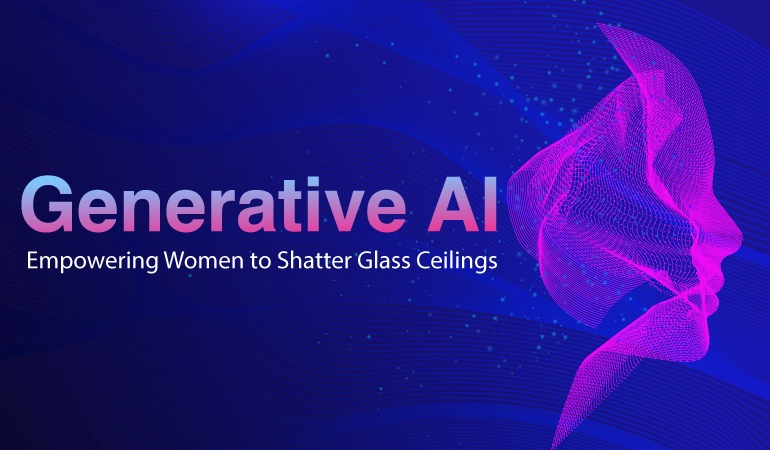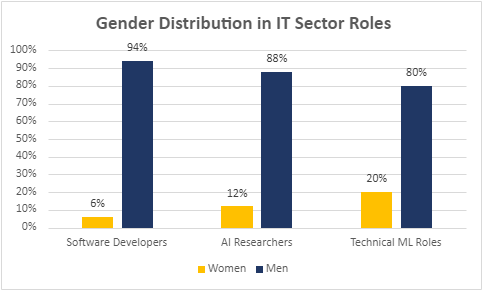
Digital technologies are reshaping the world at a lightning pace. While there are opportunities galore, there is no shortage of challenges either – cutting-edge tools and platforms are causing panic amongst some segments of society. Working women, historically marginalized in the labor market, are one such segment that is under increasing pressure to cope with a rapidly changing job market landscape. Can generative AI come to their rescue? Or will it cause further digital divides?
This article explores the challenges women face in the age of artificial intelligence solutions and how generative AI can empower women to overcome related challenges. It also explains how companies can foster a more inclusive and gender-sensitive approach toward adopting such technologies.
Let’s begin with some facts.
The Need to Build a Gender-Inclusive Tech Landscape
According to a UNESCO press release, women and girls worldwide are “25% less likely than men to know how to leverage digital technology for basic purposes, 4 times less likely to know how to program computers, and 13 times less likely to file for an ICT patent.”

It also adds that women occupy only 20% of technical machine-learning roles at companies. Moreover, only 6% of the world’s professional software developers and 12% of AI researchers are women. What a glaring digital divide, indeed.
While the issues of gender inequality have deeper, more structural causes with socio-political underpinnings, modern technologies like LLMs (large language models) have a huge potential to help us overcome such digital divides. And the need to do so has never been greater.
As UNESCO Director-General Audrey Azoulay said, “There is an urgent need to rebalance the situation for women in AI to avoid biased analyses and to build technologies that take into account the expectations and needs of all of humanity.”
UNESCO has taken a significant step toward reducing the digital gap by setting up an all-women collaborative platform called Women4Ethical AI. Its goal is to support companies and governments worldwide to ensure that women are adequately represented in the design and deployment of AI-based technologies.
Let’s discuss how generative AI can help encourage gender equality.
What is Generative AI?
Generative AI is a class of artificial intelligence systems and algorithms designed to create and produce novel content, data, or outputs that mimic and expand upon patterns, styles, or structures found in existing data.
Unlike traditional AI models that primarily focus on recognition, classification, or prediction, generative AI models have the remarkable ability to generate new, original content autonomously, such as text, images, music, or even entire software codes.
These AI systems operate by learning from large datasets and language modeling and capturing the underlying relationships, patterns, and characteristics within that data. Once trained, they can generate content that resembles or extends the examples they were exposed to during training.
The power of generative AI can be applied across various domains, including natural language processing, computer vision, and creative arts. It has the potential to revolutionize industries by automating content creation, enhancing human creativity, and enabling the development of new, innovative applications.
Leveraging Generative AI to Empower Women
Generative AI, because it can generate unique content in a matter of seconds, has incredible potential for improving gender equality. It can play a critical role (if leveraged properly) in helping women build brighter, better futures for themselves.
Let’s see how they can achieve this by harnessing the power of gen AI.
1. Self-education through Gen AI
Lack of access to quality education, especially for women from developing countries, has been one of the greatest roadblocks to women’s empowerment. Young girls and women globally face the challenge of societal biases and educational barriers like lack of resources, not to mention sexual harassment.
Generative AI tools like ChatGPT, Midjourney, Bard, etc., can provide a solution to overcoming the gendered educational divide.
Women can leverage these tools for personalized learning. AI-powered EdTech platforms can deliver tailored content to individual learners, allowing women to access customized educational experiences that suit their learning styles and pace. This makes learning not only effective but also more engaging.
It can also help them learn new languages by providing accurate real-time translations of other languages, giving pronunciation guidelines, and enabling them to communicate better with others.
2. Skill Development
Although one can consider skill development as part of education, we believe it merits a mention of its own. Generative AI can truly empower women to get past the workforce disparities in terms of opportunities and wages. As a young girl who wants to learn how to write content or design images, you can use AI-driven platforms to acquire these new skills.
One can even pursue a career in STEM (science, technology, engineering, mathematics) fields by learning relevant skills through AI-powered online training programs and courses.
Such skill development automatically opens doors to new work opportunities for women and also significantly improves their chances of earning a better salary, one that is close to or commensurate with men’s salaries.
3. Improved Healthcare Access
Access to quality healthcare is a universally accepted fundamental right, yet women in developing countries hardly get any proper medical attention. Lack of healthcare facilities, inadequate infrastructure, poor education, patriarchal norms, etc., restrict women’s access to sound healthcare.
Generative can overcome these healthcare barriers for women. For example, women can use AI-powered telemedicine applications that enable them to consult with healthcare professionals remotely.
Such arrangements can work wonders in areas that don’t provide medical facilities. It can surely improve maternal care and reduce infant mortality rates. However, governments first need to provide digital infrastructure and raise awareness before such initiatives can succeed.
4. Combating Gender-Based Violence
Generative AI can also contribute to addressing one of the most pressing global issues: gender-based violence. Governments and NGOs can employ gen AI tools to raise awareness, provide resources, and offer support to survivors.
AI-driven mobile apps can provide discreet assistance to women facing dangerous situations. These apps can send distress signals, share location information, and connect women with local authorities or support networks.
One of the most promising domains where gen AI can reap massive results is predictive analytics. Law enforcement agencies and community support groups can use AI to analyze data and identify areas with high rates of gender-based violence. This information can help organizations and policymakers allocate resources and develop strategies to combat this pervasive issue in a targeted, efficient manner.
Pitfalls for Gender Equality in Generative AI
There is much to hope for in terms of bettering the lot of women given the rise of generative AI. However, there is a flip side to it as well. Generative AI, as explained earlier, is trained on datasets fed to large language models with NLP (natural language processing) techniques. If you feed the training model faulty data that is biased, it will give biased results.
For example, both OpenAI and Google, developers of ChatGPT and Bard, respectively, admit that their products can give faulty and biased responses to prompts.
In this sense, if the datasets these models are trained on are biased, the models will only give biased outcomes, thus further embedding gender inequality in society at large. An example of biased data can be when doctors use AI-generated diagnoses that utilize evidence gathered only from men.
Therefore, there is an urgent need to ensure that large language models are trained on inclusive and representative datasets so that no segment of the community is discriminated against.
As OECD Deputy Secretary-General Ulrik Knudsen said at an event to celebrate International Women’s Day 2022, “If we do not promote the fair and full participation of girls and women in the digital future of our societies, we are setting ourselves up for a digital future that will be less rich, less innovative and less fair.”
Summing it Up
Every new technology brings with it a new set of opportunities and challenges. Our goal, then, is to make the most of the opportunities available and overcome the challenges insofar as it is possible.
Artificial intelligence, especially its branch of generative AI, has the potential to really change the world – and it already is. From marketing jobs to education and artistic expression, generative AI is impacting everything around us. Governments around the world need to leverage generative AI to improve gender equality. We can overcome the digital divide between men and women by making proper use of this highly promising technology.
Xavor has made a significant step towards lessening the gender divide in Pakistan by launching a 3-month intensive Generative AI Bootcamp that focuses on empowering women and underserved communities.
As part of the program, bootcamp participants will learn leading technical and soft skills, work on projects grounded in real-world problems, and use Xavor’s domain-specific knowledge in building AI products. International AI thought leaders and Xavor’s AI and Robotics teams will guide and mentor the candidates on their project work through the entire length of the program. A truly unique and exciting opportunity!
Drop us a line at [email protected] to learn more about how Xavor can help you leverage AI to deliver innovative solutions.
